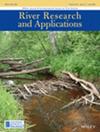池型鱼道中伊比利亚带鱼上游运动的偏置孔和直孔的通过效率
IF 1.7
4区 环境科学与生态学
Q4 ENVIRONMENTAL SCIENCES
引用次数: 31
摘要
粗大鱼种是河流中的优势鱼种,但在鱼类通道研究中往往被忽视。关于水力学对这些物种的运动和游泳性能的影响的详细知识非常有限。在本研究中,对池型鱼道原型中的偏置孔和直置孔是否适合伊比利亚带鱼(Luciobarbus bocagei)上游运动进行了测试。文中还分析了水流速度和湍流描述符对鱼类游泳性能的影响。总体而言,偏移配置的鱼通过成功率(68%)明显高于直线配置(28%)。当鱼道采用偏移配置时,成功通过鱼道所需的时间也显着降低,特别是对于小个子成年人。在所有分析的水力参数中,雷诺兹剪切应力(RSS)似乎是对鱼道内伊比利亚带鱼运动影响最大的一个。研究结果证明,刺鱼的游泳性能和通过鱼道成功向上游迁移的能力在很大程度上取决于鱼道内孔和湍流的安排,特别是RSS。建议对其他“弱”游泳者进行更详细的研究,以改进未来适合其他粗糙物种的池型鱼道设计。版权所有©2010 John Wiley & Sons, Ltd本文章由计算机程序翻译,如有差异,请以英文原文为准。
Passage efficiency of offset and straight orifices for upstream movements of Iberian barbel in a pool‐type fishway
Although coarse fish species are frequently the predominant taxa found in rivers, they are often neglected in fish passage studies. Detailed knowledge on the impact of hydraulics on the movements and swimming performance of these species is very limited. In this study, offset and straight orifices in a pool‐type fishway prototype were tested in terms of their suitability for Iberian barbel's (Luciobarbus bocagei) upstream movements. The effects of water velocity and turbulence descriptors on fish swimming performance were herein also analysed. Overall, the offset configuration was found to have a significantly higher rate of fish passage success (68%) than the straight arrangement (28%). The time taken to successfully negotiate the fishway was also significantly lower when it featured an offset configuration, particularly for small adults. Of all analysed hydraulic parameters, Reynolds shear stress (RSS) seemed to be the one that most strongly influenced the movements of Iberian barbel within the fishway. The findings provide evidence that the barbel's swimming performance and capacity to successfully migrate upstream through a fishway strongly depend on the arrangement of orifices and turbulence, in particular RSS, within a fish pass. More detailed research focusing on other ‘weak’ swimmers is recommended to improve future designs of pool‐type fishways suitable for other coarse species. Copyright © 2010 John Wiley & Sons, Ltd.
求助全文
通过发布文献求助,成功后即可免费获取论文全文。
去求助
来源期刊

River Research and Applications
环境科学-环境科学
CiteScore
4.60
自引率
9.10%
发文量
158
审稿时长
6 months
期刊介绍:
River Research and Applications , previously published as Regulated Rivers: Research and Management (1987-2001), is an international journal dedicated to the promotion of basic and applied scientific research on rivers. The journal publishes original scientific and technical papers on biological, ecological, geomorphological, hydrological, engineering and geographical aspects related to rivers in both the developed and developing world. Papers showing how basic studies and new science can be of use in applied problems associated with river management, regulation and restoration are encouraged as is interdisciplinary research concerned directly or indirectly with river management problems.
 求助内容:
求助内容: 应助结果提醒方式:
应助结果提醒方式:


